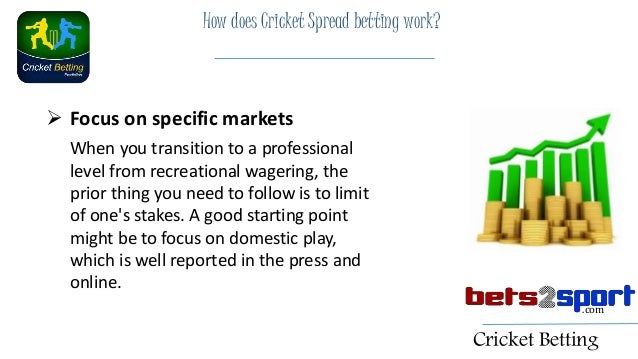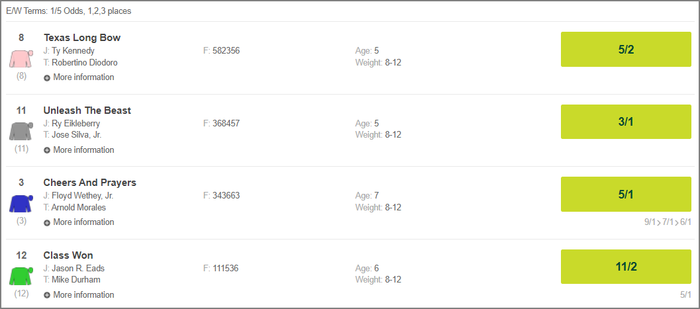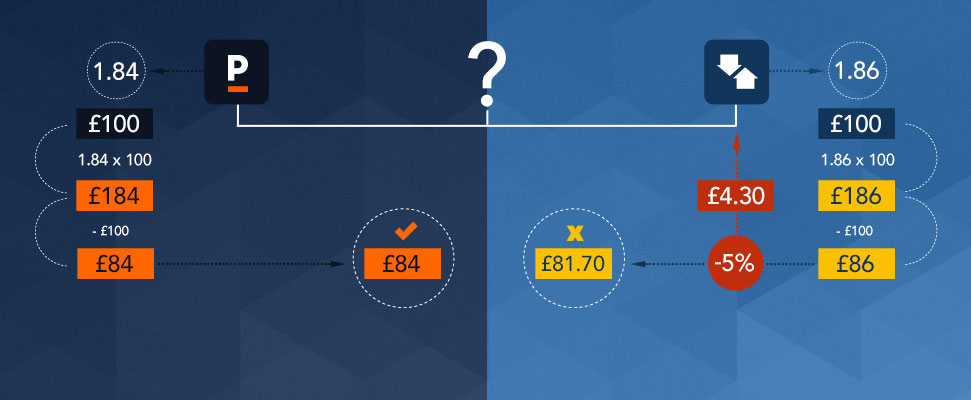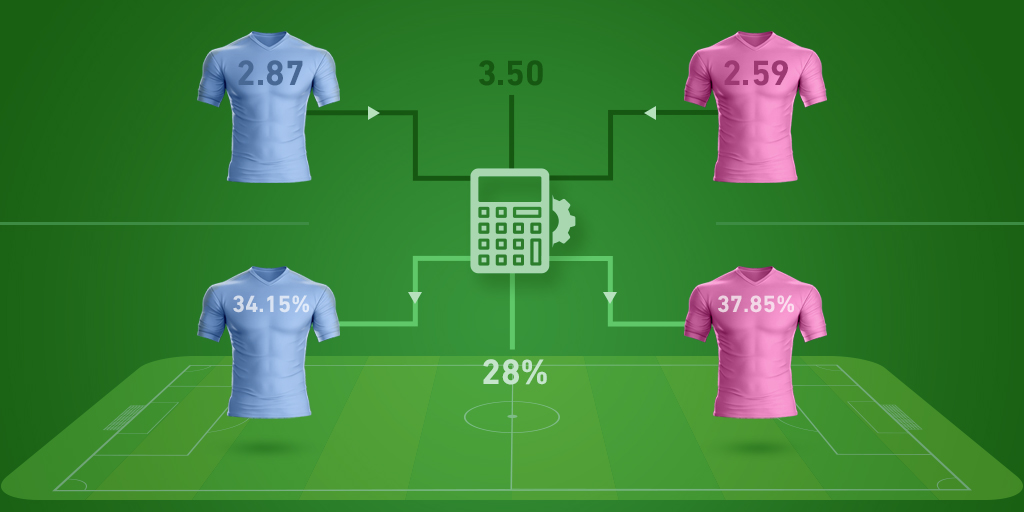Sports odds work by offering gamblers the chance to profit if they can correctly guess the outcome of a sports event or predict something that happens in sports. The odds represent the financial contract between the gambler and the bookmaker. The three main ways that sports odds are displayed are known as American odds, fractional odds and decimal odds. These three types of odds look different but represent the same thing: the payout for a winning bet in relation to the amount of money that was bet. Point spreads and over-under bets are other types of sports odds.
- Thinking of getting into live cricket betting? Click here to understand how cricket betting odds work and the different cricket betting options you have.
- As explained betting odds indicate the probability and the chances of an outcome whether come in a fractional, or decimal, or as American odds. Also, sportsbook odds show us the possible winning amount, if we placed our money bet on the right outcome. But, lets start learning and understanding how to.
- Understanding how betting odds work is crucial for success in gambling, whether you want to win at slots or place bets on sporting events. By knowing the odds of potential bets you can calculate your expected winnings and build an entire strategy for a successful session.
- Betting odds represent the probability of an event to happen and therefore enable you to work out how much money you will win if your bet wins. As an example, with odds of 4/1, for every £1 you bet, you will win £4. There is a 20% chance of this happening, calculated by 1 / (4 + 1) = 0.20.
Casinos and sportsbooks profit when they have to pay out less than they receive in bets. They also collect a commission — sometimes called the 'juice' — on certain bet to increase their chances of making a profit. Sports odds typically are set so that the bookmaker can expect equal betting on each side of the bet, which would ensure that the bookmaker would not lose money, no matter what happens in the sports event. If the bookmaker collected juice on each bet, the bookmaker would be guaranteed to profit if the betting on each side was equal.
Betting Basics In essence, when you are making a bet, you are depositing money with the bookmaker. If the bet is unsuccessful, the bookmaker keeps the deposited money. However, if the bet is successful, then the bookmaker has to pay out the client the deposited sum multiplied by the odds of the winning bet.
American Odds
One common way for bookmakers in the United States to display sports odds is to show either a plus sign (+) or minus sign (-) followed by a number. Odds with a minus sign represents how much money must be bet on a favorite — the team or competitor that is expected to win — in order to win $100 US Dollars (USD), and odds with a plus sign show how much money would be won if $100 USD was bet on an underdog — a team or competitor that is not expected to win. For example, the odds for betting on a favorite might be displayed as -120, which means that a gambler must bet $120 USD to win $100 USD. The odds for betting on an underdog might be displayed as +115, which means that for a winning bet of $100 USD, the gambler would make $115 USD. In a sports event that has one favorite and one underdog, such as a football game, the number listed in the odds for the favorite is higher than the number in the underdog's odds, which increases the bookmaker's chances of making a profit.
Gamblers should be aware that when American odds are used, the total payout for a winning bet is $100 USD more than the number displayed. For example, if a man bet $120 USD on a favorite with -120 odds and won the bet, he would receive a total of $220 USD back from the bookmaker — his original $120 USD bet plus the $100 USD that he won. Likewise, if he won a $100 USD bet on an underdog with +115 odds, he would receive a total of $215 USD back — his $100 USD bet plus the $115 USD he won.
It is not always necessary to bet exactly the amount shown. A gambler might choose to bet much more than $100 USD or want to win more than $100 USD. For example, a woman could bet $3,000 USD on an underdog with +130 odds, and if she won the bet, she would get back a total of $6,900 USD — her original $3,000 USD bet plus $3,900 USD, which is $130 USD for each $100 USD of her bet.
Fractional Odds
In the United Kingdom and in horse racing everywhere, odds typically are displayed in fractions, such as 8/5, 3/1 or 10/1. When spoken, these odds are read like ratios, such as 'eight to five,' 'three to one' or 'ten to one.' The first number is the amount of money that can be won on a bet in the amount of the second number. For example, if a gambler won a bet at 3/1 odds, he or she would win $3 USD for every $1 USD that was bet. Like American odds, the payout number does not include the amount of the original bet, which also is returned to the gambler. So a man who won a $250 USD bet at 3/1 odds would receive $1,000 USD back from the bookmaker — his original $250 USD bet plus his $750 USD winnings.
Decimal Odds

Unlike American odds and fractional odds, decimal odds show the gambler exactly what the payout will be based on the amount of the bet — the return of the original bet amount is built into the number. As the name implies, decimal odds are expressed in decimals, such as 1.50, 2.50 or 4.25. In these three examples, a winning bet of $200 USD would result in a total payout of $300 USD, $500 USD or $850 USD, which are simply the amount multiplied by the decimal shown in the odds. Decimal odds must be higher than 1.00, or even a winning bet would result in the gambler losing money. This method of displaying sports odds is popular in Canada, continental Europe and Australia.
Point Spreads
For a sports event in which a score is kept, gamblers can bet on who will win as well as the margin of victory. Betting on who will win is referred to as a straight-up bet or betting on the moneyline, and betting on the margin of victory is referred to as a point-spread bet. Point spreads are expressed in numbers preceded by minus signs for favorites and plus signs for underdogs, such as -7.5 for a favorite in an American football game and +7.5 for the underdog in the same game.
A bet on a favorite is won when the favorite wins the game by more than the point spread, and a bet on the underdog is won when the underdog wins the game or loses by less than the point spread. For example, if a gambler bet on a team at a point spread of +8 and the team lost by only six points, the gambler would win the bet. On the other hand, if a gambler bet on a team at a point spread of -6 and the team won by only one point, the gambler would lose the bet. Bookmakers typically set the point spread based on both the expected result of the game and what odds will bring in equal betting on both sides.
Point spreads are sometimes listed with odds for the bet, such as -7(-110), -7(11/10) or -7(2.10). All of these odds represent the same bet — a team favored by seven points, with winnings of $11 USD for every $10 USD that is bet. If no odds are displayed with the point spread, it typically is implied that the odds are -110, 11/10 or 2.10.
Over-Under
Another common way to bet on sports event in which a score is kept is the over-under bet, also called betting on the total. In this type of bet, the gambler is betting on the total points scored in the game, regardless of how many points each team scores or which team wins. For example, if the over-under for a basketball game is 180, a gambler could bet the 'over' and win if more than 180 total points are scored or could bet the 'under' and win if fewer than 180 total points are scored. Just like point spreads, over-under bets typically are implied at -110, 11/10 or 2.10 odds unless otherwise specified.
Other Types of Bets
There are seemingly endless other ways for gamblers to bet on sports. Just a few examples are future bets, in which the bet depends on a result that will take place much later, such as a betting before the season on which team will win the championship; parlays, in which gamblers bet on multiple things and must win all of the bets to receive the payout, usually at very high odds; and proposition bets, in which gamblers bet on very specific results, such as the points scored by a single player or the number of times a certain thing happens in a game. There also are over-under bets that involve things other than the total points scored, such as the combined number of free throws for both teams in a basketball game or the combined number of passing yards for both teams in an American football game.
Golf betting can be one of the more profitable ventures of the major sports, with upward of 150 golfers teeing it up each week. The larger fields provide odds considerably longer than what are seen in any other sport. Golf fans also have a variety of options from which to choose — the PGA Tour, European Tour, Korn Ferry Tour and LPGA. Below, we look at the best ways to bet on golf, along with definitions of key terms and an explanation of the odds.
Golf betting: Ways to bet
Access USA TODAY Sports’ betting odds for a full list of today’s sports betting odds and lines.
Outright: Picking a winner from a field of 120-155 golfers isn’t quite as daunting as it seems. The Golfweek/Sagarin world rankings are an effective measure to compare different golfers, as are course history and statistics. Odds can range from +800 (8-to-1) to +30000 (300-to-1), though winners generally come from the +2000 to +10000 range.Placing: Not as profitable as outright wins, but bettors can instead back multiple golfers to finish in the top 5, top 10, or even top 20 in order to ensure at least a moderate profit each week. These bets are best for long shots, as the outright odds for each golfer will decline according to the wider the range of their finishing position.Matchup: Golfers from a similar world ranking or geographical region — or who share a tee time — are put in head-to-head or three-ball matchups, with the winner the golfer who posts the lower round or tournament score. Odds typically range from -150 to +150.
 Groups: World rankings, notoriety or nationality can place golfers in groups of six to 10 for the lowest four-round tournament score. Odds can range from +100 to more than +2000 depending on the number of golfers included in the group and their world ranking.Round betting: Instead of backing golfers for a full 72 holes, look for 18-hole leaders or placings at the end of the first, second or third rounds. First-round leader odds can be higher than the tournament odds for the favorites while dropping slightly for the long shots.Live betting: Jump in on outright odds at any point after the first tee shot. Odds will be adjusted based on the current leaderboard and the positioning of the pre-tournament favorites. It’s often best to hope a favorite starts poorly relative to the rest of the field and back them once the odds spike.Props: Generally the least profitable and predictable of the odds in golf; bettors can bet on whether a hole-in-one will be made, or the winner’s final score, for example.
Groups: World rankings, notoriety or nationality can place golfers in groups of six to 10 for the lowest four-round tournament score. Odds can range from +100 to more than +2000 depending on the number of golfers included in the group and their world ranking.Round betting: Instead of backing golfers for a full 72 holes, look for 18-hole leaders or placings at the end of the first, second or third rounds. First-round leader odds can be higher than the tournament odds for the favorites while dropping slightly for the long shots.Live betting: Jump in on outright odds at any point after the first tee shot. Odds will be adjusted based on the current leaderboard and the positioning of the pre-tournament favorites. It’s often best to hope a favorite starts poorly relative to the rest of the field and back them once the odds spike.Props: Generally the least profitable and predictable of the odds in golf; bettors can bet on whether a hole-in-one will be made, or the winner’s final score, for example.What Does +100 Odds Mean
Futures: Continuously scouting the futures odds for the Masters, PGA Championship, US Open, Open Championship or the Ryder Cup can offer great value. Look for changes among the world’s top-ranked values and back them to win a major following a poor stretch of results in regular tournament play.Golf betting: Key betting terms to know
Favorites: Typically based on world ranking, but others with strong course history or on a hot stretch of recent top finishes can be viewed as a tournament favorite with odds lower than +2000. Be wary of low-ranked golfers with lower odds than they’d normally possess.Long shots: Priced at +5000 or higher, golfers who generally haven’t won much or have poor history on a particular course. Value exists when spotting a top-ranked golfer who has slipped into this range in a particularly strong field.Chalk: Referring to a heavy favorite priced at +1000 or higher. These golfers are never worth a bet as a broad rule, as the return simply isn’t worth the risk. Be cautious of a heavy favorite in an otherwise weak field.How Does Sports Odds Betting Work
Parlay: Just like grouping bets from multiple different games in other sports, bettors can back outright winners from different pro tours. It’s a good way to get value on the heavy favorites from both the PGA Tour and LPGA in the same week.Golf betting: How do odds work?

As noted above, outright odds in a typical tournament can range from +800 to +30000, depending on how many golfers are in a field and the overall strength of a field. These odds mean a $10 bet can return a profit anywhere from $80 to $3,000.
Several golfers should be backed each week as an outright winner, with a larger portion of your bankroll being devoted to placing, matchup or group bets in order to ensure at least a small return on your weekly investment. There’s nothing worse than having your sneaky long shot finish second or third and not getting anything for it.
Get some sports betting action by placing a bet with BetMGM today. For more sports betting picks and tips, visit SportsbookWire.com.
How Does Betting Odds Work In Horse Racing

Follow @EstenMcLaren on Twitter, and follow @SportsbookWire on Twitter and Facebook.
How Sports Betting Odds Work
Gannett may earn revenue from audience referrals to betting services. Newsrooms are independent of this relationship and there is no influence on news coverage.